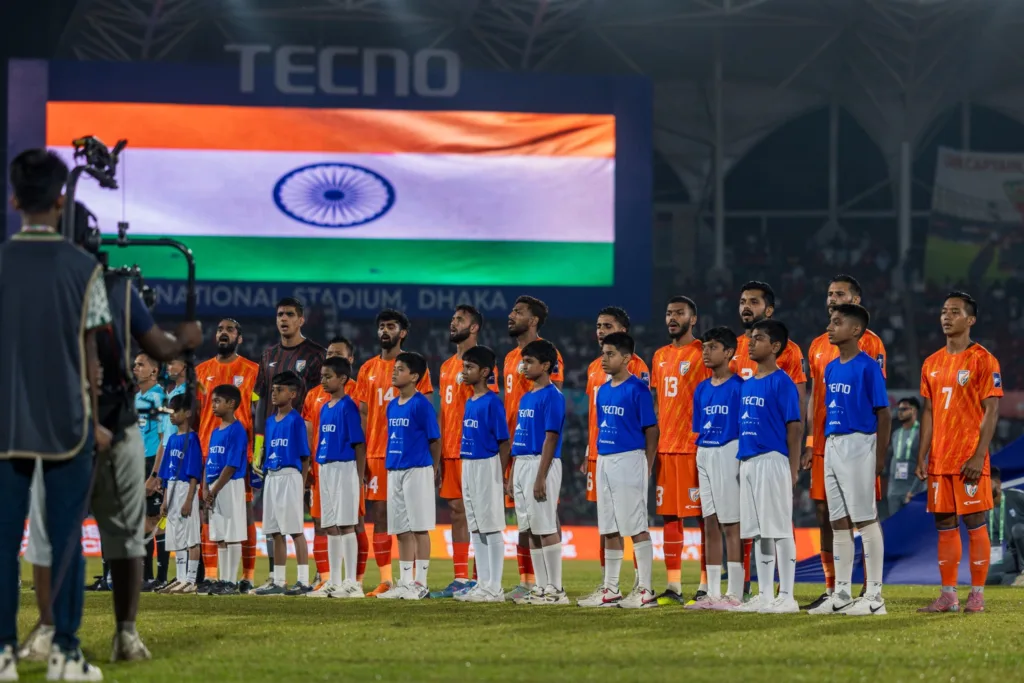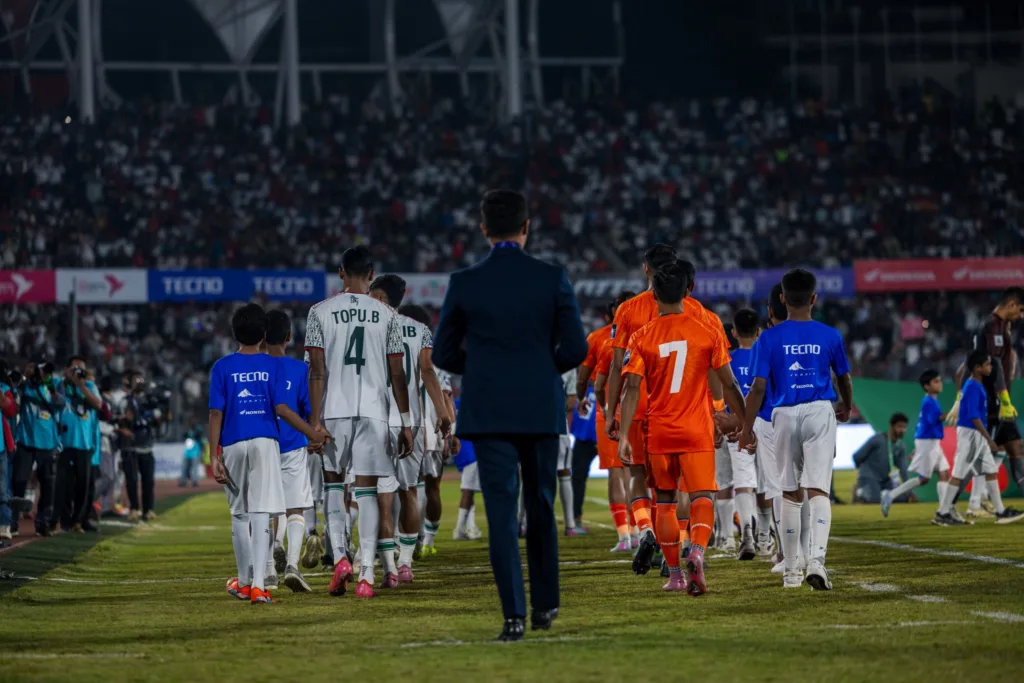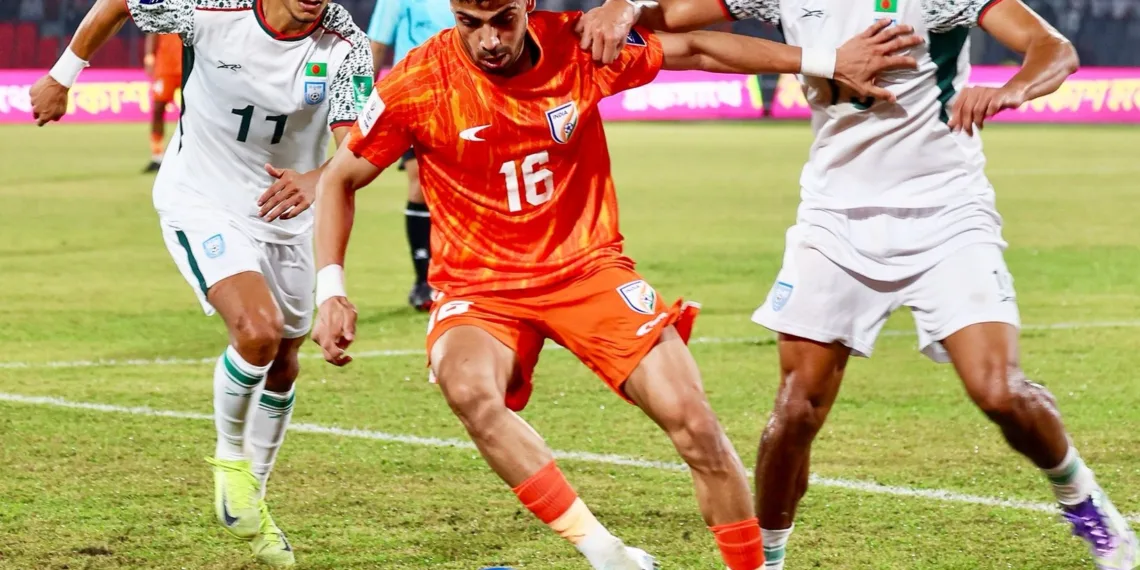In what can only be described as one of the darkest days in Indian football history, India crashed to a humiliating 1-0 defeat against Bangladesh in Dhaka on November 18, 2025, marking their first loss to their neighbors in 22 years. The shocking result at the National Stadium condemned the Blue Tigers to the bottom of Group C in the AFC Asian Cup 2027 qualifiers, capping off what has been an abysmal campaign that has left fans questioning the future direction of Indian football.
This was Bangladesh’s first win over India in 22 years, since they last beat them 2-1 at Dhaka in 2003. The defeat not only represents a historic low for the Indian national team but also ensures that even if they win their last group game against Hong Kong in March 2026, they will finish behind Bangladesh on head-to-head record, cementing their position at the bottom of the standings.
Table of Contents
The Match That Broke Indian Hearts
The match at Dhaka’s packed National Stadium started disastrously for India and never improved. In the 11th minute, Centre-forward Rakib Hossein squared up Akash Mishra down the Indian right flank on a counter, raced past him before holding off him and Nikhil Prabhu to poke a ball into the box. With Gurpreet Singh Sandhu hesitating, 19-year-old Shekh Morsalin raced in and gently lifted a nonchalant finish over Gurpreet’s legs and into the goal.
| Match Statistics | India | Bangladesh |
|---|---|---|
| Final Score | 0 | 1 |
| Possession | Higher (2nd half) | Controlled (1st half) |
| Clear Chances | 3 | Multiple counters |
| Goal Scorer | – | Shekh Morsalin (11′) |
| Man of the Match | – | Rakib Hossein |
That early goal proved to be the only strike of the night, but it was enough to hand Bangladesh a famous victory in front of their boisterous home crowd. The atmosphere inside the stadium was electric, with Bangladeshi fans creating a cauldron of noise that rattled the visiting Indian players from the opening whistle.

The first half of the match was commanded by Hamza Choudhury who appeared to be everywhere. One minute he was heading away a Lallianzuala Chhangte off the line, the other he was lining up a difficult chest-and-volley chance at the edge of the Indian box. The former Leicester City midfielder’s performance symbolized Bangladesh’s determination and tactical discipline throughout the contest.
India’s Toothless Second-Half Performance
Despite making changes and showing more urgency in the second half, India lacked the cutting edge required to break down a resilient Bangladesh defense. The second half was livened up by the introduction of Mahesh Singh from the off and debutant Mohammed Sanan a while later. Mahesh had a shot that whizzed wide, while Bheke did the same with a powerful header while Sanan saw a smart shot saved well by the busy Mitul Marma in Bangladesh’s goal.
These three chances represented the closest India came to salvaging something from the match, but each opportunity was either misdirected or well-saved. The Indian attack, playing without the inspirational presence of retired legend Sunil Chhetri, appeared disjointed and lacking in creativity against opponents they would historically have been expected to dominate.
Bangladesh goalkeeper Mitul Marma deserves significant credit for his performance, making crucial saves when called upon and organizing his defense expertly. Alongside him, defenders like Topu Barman and Hamza Choudhury formed an impenetrable wall that frustrated every Indian attacking move.
The Broader Context: India’s Worst Year in Football History
This defeat represents merely the latest chapter in what has been a disastrous 2025 for Indian football. For their opponents, meanwhile, this was yet another misstep in what is turning out to be one of the worst years in Indian footballing history.
| India’s 2025 Campaign | Matches | Wins | Draws | Losses | Points |
|---|---|---|---|---|---|
| AFC Asian Cup Qualifiers | 5 | 0 | 2 | 3 | 2 |
| Overall Record | 10 | 2 | 5 | 3 | – |
India have just 2 points from 5 matches and Khalid Jamil’s side has not won a single game in the group till now. This has been an very embarrassing campaign for the Blue Tigers. The statistics paint a bleak picture of a team that has consistently failed to meet even modest expectations throughout the qualifying campaign.
The Blue Tigers’ qualification hopes had already ended following their 2-1 defeat to Singapore in Goa on October 14, a result that left them with just two points from four games at that stage. The Bangladesh match, while technically meaningless in terms of qualification, carried significant importance for FIFA ranking points and national pride, both of which India lost spectacularly.
FIFA Ranking Collapse: A Nine-Year Low
India’s poor form throughout 2025 has been reflected in their catastrophic FIFA ranking decline. The national team currently sits at 136th in the world rankings, their lowest position in nine years and a far cry from their best-ever ranking of 94th achieved in February 1996.
The Indian men’s football team slumped to its lowest ranking in nine years as it dropped six places to 133rd in the latest FIFA rankings released in July 2025, courtesy two losses in June. The subsequent defeats have only accelerated this downward spiral, with India now ranked 24th among the 46 Asian Football Confederation nations.
The ranking collapse has serious implications beyond mere numbers. Lower rankings affect seeding in future qualifying draws, making India’s path to major tournaments even more challenging. It also reflects poorly on the country’s football development programs and raises questions about the efficacy of current coaching methodologies and player development systems.
Coaching Carousel: Three Coaches in One Year
The instability in India’s coaching position has undoubtedly contributed to the team’s poor performances. The year began with Manolo Marquez at the helm, but his tenure ended in mutual termination on July 2, 2025, following a series of disappointing results.
On 1 August 2025, the AIFF announced the appointment of Khalid Jamil as head coach, making him the first Indian head coach of the national team since Savio Medeira left the role in 2012. However, Jamil’s appointment has failed to reverse India’s fortunes, with the team remaining winless in competitive fixtures under his guidance.
The coaching changes highlight the All India Football Federation’s reactive rather than strategic approach to team management. Without continuity and a clear long-term vision, the national team has struggled to develop cohesion and implement consistent tactical approaches.
Squad Selection and Missing Key Players
The match against Bangladesh was notable for several absences and selection controversies. Most significantly, Australia-born forward Ryan Williams, who recently secured an Indian passport and generated considerable excitement among fans, was unavailable for selection.
Ryan Williams made headlines after switching nationality to represent India, but his Football Australia NOC didn’t arrive in time. He misses today’s match and will now debut in March. Williams’ absence deprived India of a potentially game-changing attacking option at a crucial moment.
The starting eleven featured a mixture of experience and youth, with captain Sandesh Jhingan leading a defense that would ultimately prove porous on the decisive goal. The midfield trio of Nikhil Prabhu, Macarton Louis Nickson, and Vikram Partap lacked the creativity and penetration needed to unlock Bangladesh’s organized defensive structure.
| India Starting XI vs Bangladesh | Position |
|---|---|
| Gurpreet Singh Sandhu (GK) | Goalkeeper |
| Rahul Bheke | Right Back |
| Anwar Ali | Center Back |
| Sandesh Jhingan (C) | Center Back |
| Akash Mishra | Left Back |
| Nikhil Prabhu | Defensive Midfield |
| Macarton Louis Nickson | Central Midfield |
| Vikram Partap | Central Midfield |
| Suresh Singh Wangjam | Attacking Midfield |
| Lallianzuala Chhangte | Right Wing |
| Rahim Ali | Striker |
Coach Khalid Jamil had emphasized youth development in his squad selection, including several uncapped players such as goalkeeper Sahil and midfielder Hrithik Tiwari. While this approach may benefit Indian football’s long-term development, it clearly compromised short-term competitive results.
Bangladesh’s Perspective: A Historic Achievement
For Bangladesh, this victory represents a monumental achievement that will be celebrated for years to come. Bangladesh seal a famous victory, their first of the qualifiers, and the stadium explodes in celebration. Twenty-two years after their last win over India in Dhaka, they’ve done it again.
The reaction of the fans and players at the final whistle demonstrated just how much this long-awaited triumph meant to Bangladeshi football. Players collapsed in joy, fans invaded the pitch in celebration, and the National Stadium reverberated with chants that lasted long after the match concluded.
Bangladesh’s victory was built on disciplined defending, organized team structure, and clinical finishing when the opportunity arose. Coach Javier Cabrera deserves immense credit for preparing his team tactically and mentally for this challenge, exploiting India’s defensive vulnerabilities with devastating efficiency.
The nineteen-year-old match-winner Shekh Morsalin became an instant national hero, his composed finish representing the culmination of Bangladesh’s football development efforts in recent years. His performance, alongside Rakib Hossein’s tireless running and Hamza Choudhury’s midfield dominance, showcased a Bangladeshi team playing with confidence and belief.
Historical Context: India vs Bangladesh Rivalry
The historical context makes this defeat even more painful for Indian supporters. Prior to this match, the head-to-head record heavily favored India, who had won eight of eighteen previous encounters while Bangladesh had claimed just one victory before this latest result.
India and Bangladesh have faced each other 18 times, with India winning eight of those meetings and Bangladesh claiming just one victory. The remaining nine encounters between the two sides have ended in draws. This lopsided record reflected India’s traditional dominance over their South Asian neighbors, making the current defeat all the more shocking.

The last time Bangladesh defeated India was in 2003, also in Dhaka, when they secured a 2-1 victory. That result stood as an anomaly for over two decades, with India subsequently avoiding defeat in their next encounters, including several draws and comfortable victories.
The most recent meeting between the nations before this match occurred on March 25, 2025, when they played to a goalless draw in their first Group C encounter. That match, while lacking quality, at least preserved India’s unbeaten record against Bangladesh in competitive fixtures, something that has now been definitively shattered.
Fan and Media Reaction: Anger and Disappointment
The reaction from Indian football fans and media has been overwhelmingly negative, with widespread criticism directed at the team’s performance, coaching decisions, and the AIFF’s management of the national program.
Social media platforms erupted with angry responses from supporters who expressed disbelief at the result. Hashtags demanding accountability from the AIFF trended nationally, with fans questioning how a nation of India’s size and resources could produce such dismal results against smaller footballing nations.
Prominent football pundits and former players have called for wholesale changes to Indian football’s structure, from grassroots development programs to elite coaching standards. Many argue that the current crisis represents a systemic failure rather than simply poor results from one team or one season.
The embarrassment is compounded by the timing, coming just months before India co-hosts the AFC U-17 Asian Cup and with the country bidding for hosting rights to future major tournaments. The national team’s poor performances undermine confidence in Indian football’s organizational capabilities and competitive standards.
The Road Ahead: Rebuilding from Rock Bottom
With qualification for the 2027 AFC Asian Cup now mathematically impossible, India faces a lengthy period without competitive international football. The team will not reconvene for another competitive fixture until November 2027, creating both challenges and opportunities for the national program.
This extended break provides time for fundamental restructuring and youth development, but it also means fewer opportunities to accumulate FIFA ranking points and maintain competitive sharpness. Coach Khalid Jamil will have to rely primarily on friendly matches to prepare his squad and experiment with new players and tactical approaches.
The remaining Group C match against Hong Kong in March 2026 has become entirely meaningless in competitive terms, though India will still need to approach it seriously to avoid further ranking damage and restore some measure of pride. However, with both teams already eliminated, the fixture lacks the intensity and importance that typically drives performance improvements.
Systemic Problems Requiring Long-Term Solutions
The defeat to Bangladesh exposes deeper structural problems within Indian football that cannot be solved by simple coaching changes or squad reshuffles. These systemic issues include:
Infrastructure deficiencies: Despite hosting the Indian Super League, India lacks sufficient high-quality training facilities and youth academies comparable to those in successful Asian footballing nations like Japan, South Korea, and Iran.
Youth development gaps: The pipeline from youth football to senior national team remains inconsistent, with talented young players often failing to develop into international-quality performers. This reflects inadequate coaching at developmental levels and insufficient competitive opportunities.
Domestic league limitations: While the ISL has improved Indian football’s commercial profile, questions remain about whether the league structure adequately develops domestic players or relies too heavily on aging foreign stars for marquee appeal.
Administrative instability: Frequent coaching changes, unclear selection criteria, and apparent lack of long-term strategic planning from the AIFF have created an environment of uncertainty and underperformance.
Physical conditioning standards: Indian players consistently appear to lack the physical conditioning and athletic qualities of opponents from other Asian nations, suggesting deficiencies in sports science application and fitness programming.
Addressing these fundamental issues requires sustained investment, expert guidance, and most importantly, a coherent long-term vision for Indian football’s development. The current crisis presents an opportunity for comprehensive reform, but only if stakeholders commit to difficult changes rather than seeking quick fixes.
Learning from Regional Success Stories
India would benefit from studying the approaches taken by other Asian nations that have successfully elevated their football programs in recent decades. Vietnam, for example, has invested heavily in youth development and imported high-quality coaching expertise, resulting in competitive teams that now regularly defeat more established nations.
Thailand and Malaysia have also made significant strides by improving domestic league standards, creating clear pathways from youth football to senior teams, and establishing professional structures that support player development. These models demonstrate that regional success is achievable with proper planning and investment.
Even neighboring Bangladesh, despite their historically weak football program, appears to be making progress through better organization, tactical discipline, and leveraging diaspora talent like Hamza Choudhury. Their victory over India, while representing an upset, was not a fluke but rather the result of systematic preparation and execution.
The Psychological Impact on Players
Beyond the tactical and organizational failures, the psychological toll on Indian players cannot be underestimated. Losing to Bangladesh represents a significant blow to confidence and morale, particularly for experienced players who would have expected to dominate such encounters.
The pressure of representing a nation of over 1.4 billion people while consistently underperforming creates immense psychological stress that can affect performance. Players face intense scrutiny from media and fans, with every mistake magnified and every defeat treated as a national catastrophe.
Creating a supportive environment that allows players to develop resilience and perform under pressure should be a priority for Indian football authorities. This includes providing access to sports psychologists, fostering positive team culture, and protecting young players from excessive criticism as they develop.
Commercial and Sponsorship Implications
The national team’s poor performances also carry commercial implications for Indian football. Sponsors and broadcasters invest based partly on team success and fan engagement, both of which suffer when results disappoint consistently.
The AIFF relies on national team matches for significant revenue, with sponsorship deals and broadcasting rights tied to performance and viewer interest. Extended periods of failure could jeopardize these commercial relationships, reducing funding available for development programs and creating a negative cycle of underinvestment and underperformance.
Maintaining sponsor confidence and fan engagement during rebuilding periods requires transparent communication about long-term plans and demonstrable progress toward stated goals. Simply accepting mediocrity while making empty promises will eventually erode commercial support.
A Critical Juncture for Indian Football
India’s defeat to Bangladesh in Dhaka represents far more than a single disappointing result. It symbolizes the culmination of years of mismanagement, strategic failures, and unfulfilled potential that have left one of the world’s most populous nations languishing in global football’s lower tiers.
The statistics tell a damning story: bottom of their qualifying group with just two points from five matches, winless throughout the campaign, currently ranked 136th in the world, and suffering their first defeat to Bangladesh in 22 years. These are not the markers of a footballing nation making progress but rather one in precipitous decline.
However, crises also present opportunities for fundamental change. If Indian football’s stakeholders can use this moment to implement genuine reforms rather than cosmetic changes, the current nightmare could eventually be viewed as the catalyst for renaissance. This requires courage, vision, and sustained commitment to building systems that develop players and create competitive teams.

For now, though, Indian football faces its darkest period in recent memory, with the humiliating defeat in Dhaka serving as a stark reminder of how far the Blue Tigers have fallen and how much work lies ahead to restore pride and competitive credibility.
Read More: Aryna Sabalenka vs Nick Kyrgios: World No. 1 Accepts Historic Battle of the Sexes Challenge in Dubai
FAQs
When was the last time Bangladesh beat India in football before this match?
Bangladesh last defeated India in 2003, also in Dhaka, when they won 2-1. This latest 1-0 victory ended a 22-year winless streak against their neighbors.
What is India’s current FIFA ranking after this defeat?
India currently sits at 136th in the FIFA world rankings, their lowest position in nine years and 24th among the 46 Asian Football Confederation nations.
Can India still qualify for the 2027 AFC Asian Cup?
No, India’s qualification hopes ended with their earlier defeat to Singapore. Even if they win their final group match against Hong Kong in March 2026, they will finish bottom of Group C.
Who scored the winning goal for Bangladesh?
Shekh Morsalin scored the decisive goal in the 11th minute, lifting a composed finish over Indian goalkeeper Gurpreet Singh Sandhu after excellent buildup play from Rakib Hossein.
Who is the current coach of the Indian national football team?
Khalid Jamil was appointed as head coach on August 1, 2025, making him the first Indian head coach of the national team since 2012, though his tenure has so far failed to produce positive results.








